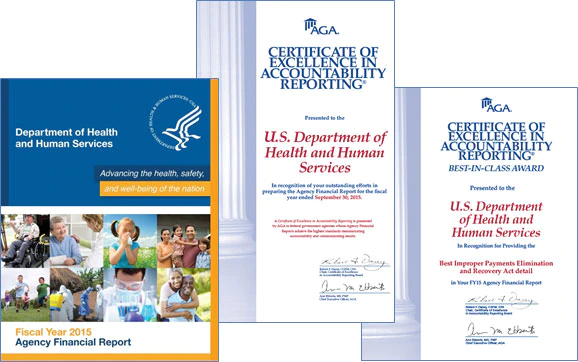Topics in This Section: Message from the Secretary | About the Agency Financial Report
Message from the Secretary

Sylvia M. Burwell
Our mission at the U.S. Department of Health and Human Services (HHS) is to enhance and protect the health and well-being of all Americans. We fulfill that mission by providing effective services and fostering advances in medicine, public health, and social services. We are committed to ensuring that every American has access to the building blocks for healthy and productive lives.
I am pleased to present HHS’s Fiscal Year 2016 Agency Financial Report. This report highlights our major accomplishments, illustrates how we manage our resources, and outlines our plans to address the challenges we face. At HHS, we are dedicated to meeting high standards of government reporting and accountability.
HHS administers more than 300 programs that enhance the well-being of others. The HHS FY 2014-2018 Strategic Plan helps guide the Department’s programs within the context of four strategic goals:
- Strengthen health care
- Advance scientific knowledge and innovation
- Advance the health, safety and well-being of the American people
- Ensure efficiency, transparency, accountability and effectiveness of HHS programs
Together, these goals form our vision for how HHS can contribute to a stronger, healthier, and more prosperous America, both today and for many years to come.
FY 2016 Highlights
The provisions of the Affordable Care Act, and our efforts to strengthen our health care system, have helped an estimated 20 million people gain health coverage since the passage of the law in 2010, a historic reduction in the uninsured. We are committed to reaching even more Americans during the fourth open enrollment of the Health Insurance Marketplace and making it easier for them to access affordable, quality health coverage. Today, no American can be denied health coverage because of a pre-existing condition, young adults can stay on a parent’s plan until they turn 26, and we have strengthened the quality of coverage.
We are also committed to advancing the health, safety, and well-being of the American people by detecting global health threats early, responding quickly, working with partners across the globe, and building the capacity necessary to deal with these threats. This commitment, and our network of global partners, helped to resolve the Ebola crisis, and it is guiding our efforts to fight the Zika virus today.
More than 50 countries and territories have active Zika virus transmission, and in February 2016, the World Health Organization declared that the clusters of microcephaly and other neurological complications associated with the Zika virus constituted a Public Health Emergency of International Concern. Tens of thousands of Zika cases have been reported in the United States and its territories, including thousands of pregnant women who are at particular risk because of the severe birth defects that Zika infection can cause. HHS is working with states and territories to improve mosquito control and increase laboratory capacity, and working with private sector partners to accelerate the development of diagnostic tests as well as a Zika vaccine. Researchers at the National Institutes of Health have been working tirelessly to develop a safe and effective Zika vaccine, and thanks to their work, NIH recently began human trials of a vaccine candidate – an important milestone they reached nearly a decade faster than with typical vaccines. It will take some time before a vaccine is commercially available, but the launch of this study is an important step forward.
To better serve the American people, we need to constantly search for new ideas and innovative ways to improve how we do business. That is where the HHS Innovation, Design, Entrepreneurship and Action (IDEA) Lab comes in. The IDEA Lab promotes the use of innovation across HHS, taking advantage of the talent of the workforce at HHS and removing the barriers that stand in their way. One of the greatest impacts we have seen has come from the Health Data Initiative, which aims to improve health and the delivery of human services by harnessing the power of data in public and private sector institutions, communities, and research groups. The initiative has liberated more than 2,100 health data sets, helping to power the growth of the health care start-up ecosystem. Unlocking health care data and information is part of the Department’s strategy to build a health care delivery system that is better, smarter, and healthier and ultimately puts patients in the center of their care.
Financial Management
As responsible stewards of the resources the American taxpayers and Congress entrust to us, one of our most important duties is to practice fiscal responsibility and transparency. To that end, our independent Department-wide financial statement audit is one of our most important tools. This year, we obtained an unmodified (clean) opinion on the Consolidated Balance Sheets, Statement of Net Cost, Statement of Changes in Net Position, and the Combined Statement of Budgetary Resources. The auditors disclaimed providing an opinion on the Statement of Social Insurance and the Statement of Changes in Social Insurance Amounts, primarily due to the uncertainties surrounding provisions of the Affordable Care Act and the impact of potential changes in law that would impact underlying assumptions of financial projections. These statements were developed based upon current law using information from the 2016 Medicare Trustees Report, as required by standards issued by the Federal Accounting Standards Advisory Board. The “Financial Section” of this report includes more detailed information.
As required by the Federal Managers’ Financial Integrity Act of 1982 (FMFIA) and the Office of Management and Budget’s Circular A-123, Management’s Responsibility for Enterprise Risk Management and Internal Control, we also evaluated our internal controls and financial management systems. We identified one material weakness relating to Information System Controls and Security. We also identified two material noncompliances relating to Error Rate Measurement and the Medicare appeals process. Our senior leadership continues efforts to improve our financial reports and systems. The “Management’s Discussion and Analysis” section of this report includes further details. Based on our internal assessments and the auditors’ report, I believe that our financial and performance data are reliable and complete.
Management Opportunities and Challenges
Despite our successes, HHS still faces opportunities for improvement. We have worked closely with the Office of Inspector General to gain its perspective about our most significant management and performance challenges, which are presented in the “Other Information” section under FY 2016 Top Management and Performance Challenges Identified by the Office of Inspector General. The HHS Inspector General identified 10 performance challenges that present opportunities for improvement. These challenges, which we are committed to overcoming, include delivering quality services and benefits, exercising sound fiscal management, safeguarding public health and safety, and enhancing cybersecurity.
Conclusion
As it has for many decades now, our Department will continue to protect the health and well-being of the American people, and of people around the globe. I have no doubt that well after this Administration concludes, the dedicated public servants here at HHS will continue to strengthen existing relationships and forge new ones with people and organizations committed to helping Americans access the building blocks for healthy and productive lives. I look forward to seeing the impact that HHS will deliver for many decades to come.
/Sylvia M. Burwell/
Sylvia M. Burwell
Secretary
November 14, 2016
About the Agency Financial Report
The HHS FY 2016 AFR provides fiscal and summary performance results that enable the President, Congress, and the American people to assess our accomplishments for the reporting period October 1, 2015, through September 30, 2016. This report provides an overview of our programs, accomplishments, challenges, and management’s accountability for the resources entrusted to us. We prepared this report in accordance with the requirements of the Office of Management and Budget (OMB) Circular A-136, Financial Reporting Requirements. This document consists of three primary sections and appendices:
Section 1: Management’s Discussion and Analysis
The Management’s Discussion and Analysis section provides an overview of the Department’s performance and financial information. It introduces its mission, and describes the Department’s organizational structure. This section highlights HHS’s goals and priorities and summarizes the results for select key performance measures. It also highlights the Department’s financial results and provides management’s assurances on HHS’s internal controls.
Section 2: Financial Section
The Financial Section begins with a message from the Chief Financial Officer. It details the Department’s finances and includes the audit transmittal letter from the Inspector General, the independent auditors’ report, and the principal financial statements and notes. The required supplementary information included in this section provides the Combining Statement of Budgetary Resources, and Deferred Maintenance and Repairs, and Social Insurance information.
Section 3: Other Information
The Other Information section begins with the Combined Schedule of Spending, Freeze the Footprint baseline square footage cost and data, and Civil Monetary Penalty Adjustment for Inflation information. It also includes the Improper Payments Information Act Report, a summary of the results of the Department’s financial statement audit and management assurances, and the Inspector General’s assessment of the Department’s management and performance challenges.
Appendices
The appendices include data that support the main sections of the AFR. This includes a glossary of acronyms used in the report and resources for connecting with the Department.
The Department has chosen to produce an AFR and Annual Performance Plan and Report. In February 2017, additional reports that will be available on HHS/About HHS/Budget & Performance (www.hhs.gov/about/budget) include:
- FY 2018 Annual Performance Plan and Report
- FY 2018 Congressional Budget Justification
Certificate of Excellence in Accountability Reporting
In May 2016, the U.S. Department of Health and Human Services (HHS) received the Certificate of Excellence in Accountability Reporting (CEAR) from the Association of Government Accountants (AGA) for its Fiscal Year (FY) 2015 Agency Financial Report. The CEAR Program was established by the AGA in collaboration with the Chief Financial Officers Council and the U.S. Office of Management and Budget to further performance and accountability reporting. Through the program, agencies improve accountability by streamlining reporting and improving the effectiveness of such reports to clearly show what an agency accomplished with taxpayer dollars and the challenges that remain. FY 2015 marked the third consecutive year the Department received this prestigious award.
AGA also presented HHS with a Best in Class Award for the Best Improper Payments Elimination and Recovery Act Detail.


